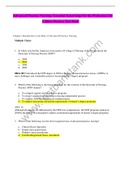Samenvatting
Summary HPI4008 Week 1 Strategic Management, Leadership and Organisational Change (HPI4008)
- Instelling
- Maastricht University (UM)
Includes a summary of all lectures and relevant course materials of week 1. I passed with a 8,8 out of 10.
[Meer zien]













